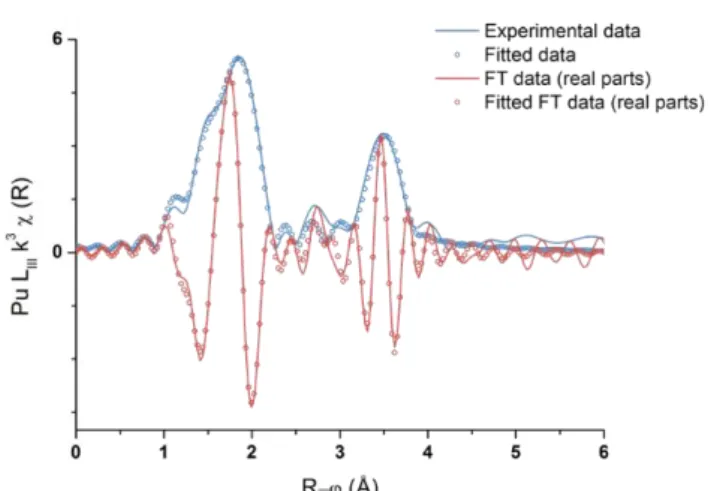HAL Id: cea-02339471
https://hal-cea.archives-ouvertes.fr/cea-02339471
Submitted on 27 Nov 2019
HAL is a multi-disciplinary open access
archive for the deposit and dissemination of sci-entific research documents, whether they are pub-lished or not. The documents may come from teaching and research institutions in France or abroad, or from public or private research centers.
L’archive ouverte pluridisciplinaire HAL, est destinée au dépôt et à la diffusion de documents scientifiques de niveau recherche, publiés ou non, émanant des établissements d’enseignement et de recherche français ou étrangers, des laboratoires publics ou privés.
Evidence for the Formation of a New Water Soluble Pu
Peroxo Complex
M. Virot, E. Dalodiere, T. Dumas, C. Tamain, O. Dieste Blanco, T. Wiss, L.
Venault, P. Moisy, Sergey I. Nikitenko
To cite this version:
M. Virot, E. Dalodiere, T. Dumas, C. Tamain, O. Dieste Blanco, et al.. Evidence for the Formation of a New Water Soluble Pu Peroxo Complex. 4th International Workshop on Advanced Techniques in Actinide Spectroscopy (ATAS 2018), Université Côte d’Azur; CEA Marcoule; CNRS; ICN Nice, Nov 2018, Nice, France. �cea-02339471�
Evidence for the Formation of a New Water Soluble Pu Peroxo Complex
M. Virot,
1E. Dalodière,
1T. Dumas,
2C. Tamain,
2O. Dieste Blanco,
3T. Wiss,
3L. Venault,
2P.
Moisy,
2S. I. Nikitenko
1 1Université de Montpellier, Institut de Chimie Séparative de Marcoule, UMR 5257, CEA-CNRS-UM-ENSCM, Site de Mar-coule, BP17171, 30207 Bagnols sur Cèze, France
2
CEA/DEN/MAR/DMRC, Nuclear Energy Division, Radiochemistry and Process Department, BP17171, 30207 Bagnols sur Cèze, France
3
European Commission, Joint Research Centre (JRC), Institute for Transuranium Elements (ITU), Postfach 2340, 76125 Karlsruhe, Germany
X oral poster Hydrogen peroxide has been considered as an important reactant in nuclear industry for the stabiliza-tion of plutonium intermediate redox states or the precipitastabiliza-tion of Pu peroxides used as precursors for PuO2 preparation. The formation of two different Pu(IV) peroxo complexes, known as brown and red
complexes, was reported to occur during the continuous addition of H2O2 to Pu(IV) acid
solu-tions.[1,2] Since the proposed structure given by Connick and W. H. McVey in 1949, only one Pu peroxo structure has been recently proposed in alkaline conditions.[1-3] The resolved peroxy-carbonate complexe concerns a Pu(IV) dimeric unit coordinated by two side-on peroxide ligands.[4] In addition to the known peroxo complex of Pu(IV), the current work demonstrates that the addition of hydrogen peroxide to slightly acid Pu(IV) aqueous solutions may lead to the observation of a green so-lution exhibiting characteristic absorption bands at 455 and 660 nm which has, up to our knowledge, never been reported in the literature. The formation of this specie can also be observed from the sonochemical oxidation of 1 mM Pu(III) solutions under Ar/O2 atmosphere (203 kHz, 250 mL, 20°C,
0.13 W mL-1). The green solution was characterized with Vis-NIR absorption spectroscopy, Raman spectroscopy, and XAFS techniques. We demonstrated the formation of a new polynuclear peroxo complex of Pu(IV) involving several Pu-O distances and at least 4 Pu atoms (Fig. 1). This water solu-ble complex was found to be stasolu-ble for several months before it slowly converts into a Pu(IV) colloi-dal suspension exhibiting the characteristic absorption band at 620 nm and a strong Mie scattering in the near UV-vis range. HR-TEM and XAFS characterizations allowed to describe these colloids as monodispersed and quasi-spherical crystalline PuO2 particles covered by hydrolyzed Pu(IV) moieties
of approximately 2.4 nm.
Fig. 1: Fourier transform of the k3-weighted EXAFS spectrum exhibiting two coordination spheres for the green peroxo complex.
[1] D. Clark, S. Hecker, G. Jarvinen and M. Neu, in The Chemistry of the Actinide and Transactinide Elements, eds. L. Morss, N. Edelstein and J. Fuger, Springer Netherlands (2011) ch. 7, pp. 813-1264.
[2] R. E. Connick and W. H. McVey, J. Am. Chem. Soc. (1949) 71, 1528-1533.
[3] G. A. Fugate and J. D. Navratil, in Separations for the Nuclear Fuel Cycle in the 21st Century, eds. G. J. Lumetta, K. L. Nash, S. B. Clark and J. I. Friese, American Chemical Society, Washington (2006) ch. 11, pp. 167-181.
